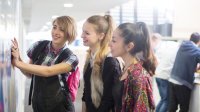Celebrating Student Interests to Create a Positive High School Culture
Events that center students’ picks in art, music, and food can create powerful opportunities for them to increase their sense of belonging.
Your content has been saved!
Go to My Saved Content.The bell rings, and lunch begins. Students move to “the commons”—our cafeteria space at school—getting in lines to pay for sammies, slices, and sides before settling into their friend groups to chat or do last-minute homework. Some are tucked behind their phones—together but alone—while others flip through the pages of a book. What if this scene could look different?
Introducing: First Fridays. Once a month, during lunch at our high school, students gather to engage in a school event that celebrates them. Modeled after the First Friday events that take place in many cities and towns (when community members gather to experience local culture), First Fridays at school offer students a chance to listen to music, view art, and sample cuisine. The tradition has become a cornerstone of our school community and is replicable across school sites.
The Importance of a Meaningful School Culture
Creating a positive school climate and culture is essential for student success. When students feel like they are an important part of the community, they’re more likely to be engaged in their learning and have a positive attitude toward school.
In my practice as an assistant principal, I knew that I needed to find a way to enhance our school culture. We had talent in our school, and I hoped our students would be brave enough to share those talents with others—fostering new connections while enlivening our community.
By making space in our routine to incorporate music, food, and art into the school environment—and, importantly, dedicating time to come together as a community—our school became more connected, and students articulated a boosted sense of belonging.
Incorporating Music
Throughout the year, we invite student musicians in ninth through 12th grades to make requests to play on First Friday, either in groups or solo. Performers choose the material they’re going to perform (provided it’s school appropriate), which offers them a sense of agency. And the community enjoys the anticipation of waiting to discover what types of music will be played, and by whom.
One student shared, “I am so thankful for First Fridays because it gives us a chance to see our friends play, and we can connect with each other through music in a group rather than just in our earbuds.”
Student performers feel a sense of pride over their work: “It was really fun. A very unique experience for sure,” one shared. From a freshman performing a piano solo to a group of seniors playing popular songs to our school’s jazz ensemble playing performance pieces, First Fridays invite a wide range of musical exposure and appreciation among attendees.
Celebrating Cuisine
Another important part of First Fridays is good food. It connects all students and cultures and provides an opportunity for community members to sample foods that they may not have tried before.
Every month, we collaborate with Food Services to suggest a theme or idea for our food tasting: From soups to sweet treats, wing sauces to macaroni and cheese bites, the surprise menu generates excitement. “We never know what the food will be, and we can’t wait to find out,” one student shared. “We also like that it is vegetarian so all kids can have the chance to try it.”
Students are given the opportunity to provide feedback and share what foods they enjoy and would like to see on the menu. These special food choices often become regulars on our lunch menu, and the process fosters deepened connections between students and food service providers, enhancing everyone’s sense of community.
Appreciating Artwork
The third component of First Friday is showcasing student artwork. In the commons, students can take a gallery walk to see pieces of art produced by their classmates. Students who observe the artwork engage in discussions with one another, express their admiration for the artists, or become motivated to produce original artwork themselves.
In addition to fostering self-esteem and confidence, this sharing of art cultivates an appreciation for creativity and expression, offers a real-world audience to student artists, and sparks conversations among students and adults who may not have previously connected.
Building a Supportive Atmosphere
At our school, what started as a small event has become a staple in our community. Students frequently share their gratitude for the tradition and say that not only do they enjoy observing their peers’ talents, but also they notice that the routine has a positive impact on their mental health and well-being.
There is a sense of calm and joy when the music is being played and students are engaging in conversation, clapping for their classmates after each song, vying for their favorite food to become a fixture on the school menu. Students’ artwork enhances the atmosphere of our physical space. And as all of these elements combine and cohere, so does our community.
